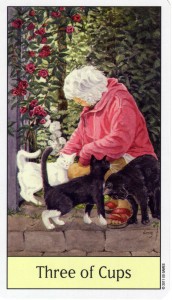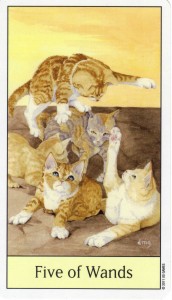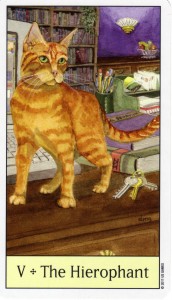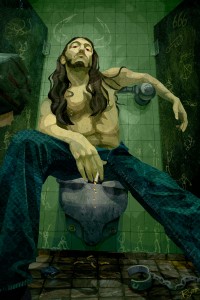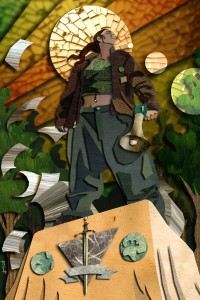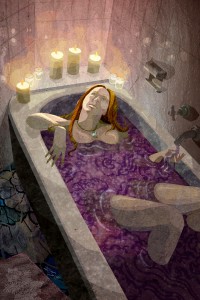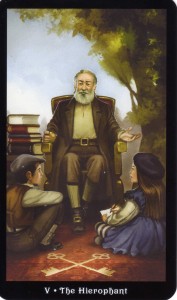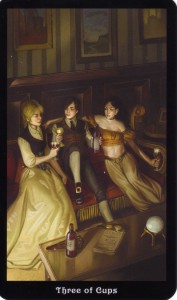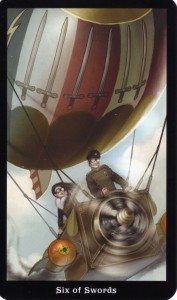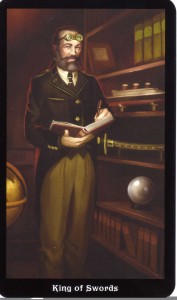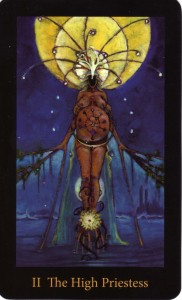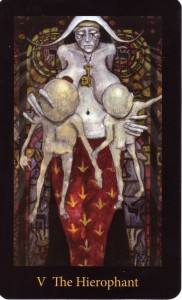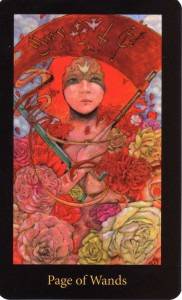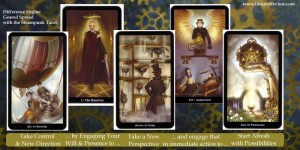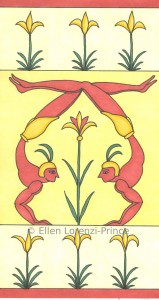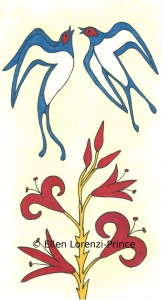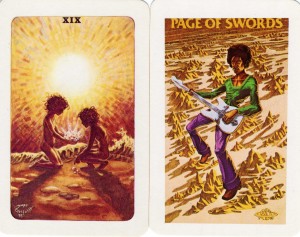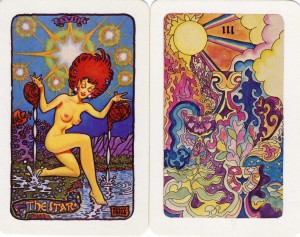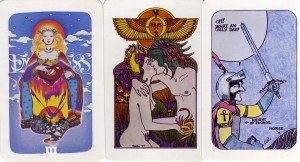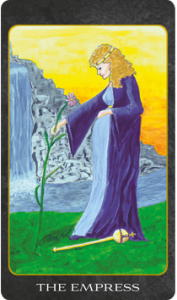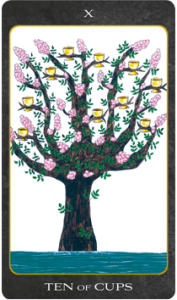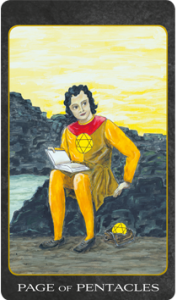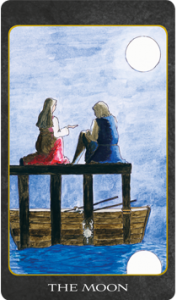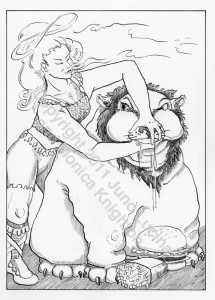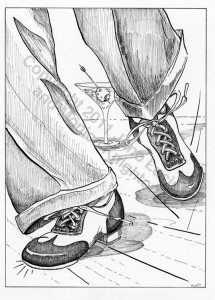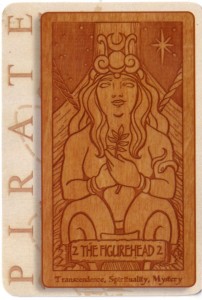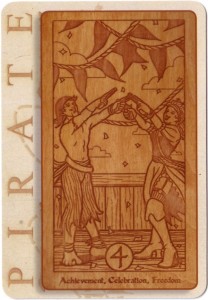The Cat’s Eye Tarot
Posted by: TheReviewer on: April 8, 2012
- In: Deck Reviews | Featured | Latest Decks
- 5 Comments
I’m a “cat personâ€. Although I only share my life with one feline companion (Erzulie, a beautiful black 5 year old moggy that came to me as a stray aged 4 weeks, who I hand fed for the first week and saw back to health) I’m definitely a “cat personâ€. I talk to other people about their cats and mine, I get all gooey-eyed over cute cat pictures on the internet, I know far too much about cat behaviour and biology than is normal for a non-veterinarian, and I regularly find myself doing things that adversely affect me just for the sake of my cat. Like sleeping at the wrong end of the bed so as not to disturb her nap. Our feline companions are truly amazing, and I regularly tell people that Erzulie was the best thing I ever did.
Despite all this, I don’t like cat Tarot decks. There’s just something about them that is weird… Tarot is about human experience, and I don’t usually find that the traditional Tarot images replaced with cats doing the same things as the traditional human counterparts in the cards gets across the meaning and archetypes of those cards as readily. Cats have a very different experience of the world. So, when I got the Cat’s Eye Tarot, I was very uncertain that I would like it at all.
But, to my surprise, I found myself liking it more and more as I looked through the cards. I appreciated it even more when I read in the accompanying LWB that the creator is a veterinarian of 28 years experience, with 22 years focusing specifically on feline practice. Working as a veterinary receptionist in my spare time made me automatically feel a connection with the creator and the deck. This isn’t just a cat lover – this is somebody who works with cats every day of her life, truly understands their behaviour, and has a special connection with them. Debra’s passion and knowledge of the feline shines through strongly in the deck, making it a joy to behold.
The Cat’s Eye Tarot is based strongly on the Rider Waite Smith tradition, retaining all the same titles and numbering in the Major Arcana with one exception: The Hanged Man becomes the Hanged Kitty. The four suits also retain their titles and associations, as do the Court Cards. This means that anybody already familiar with traditional Tarot, even if that knowledge is only basic, can pick up the Cat’s Eye Tarot and feel familiar.
The strength of this deck really lies in its Minor Arcana, which are not only extremely easy to read, but also express the feline point of view of the card meanings without making them obscure. They’re also extremely cute, in places funny, at times sad and tear-inducing (particularly for us “cat peopleâ€!) and beautiful. The traditional card meanings are innovatively illustrated, which means that the Cat’s Eye Tarot is a good deck for more advanced readers to look at and use to shake themselves out of old, tired reading habits or to gain new perspectives and insights into the cards. For example, the Five of Wands, a card traditionally concerned with conflict, inner conflict, or some sort of opposition that is in some way “friendlyâ€, designed to improve the fighters with no dire consequences. In the Cat’s Eye Tarot we see five ginger and white kittens who are almost of the age when they are ready to leave their mother, fighting amongst themselves in the typical playfight found throughout the world in cat litters. This playful conflict teaches the kittens useful skills that they will need later in life: stalking and hunting, power and dexterity. It may sometimes look nasty, but it all serves a purpose. The Ten of Wands shows a cat proudly bringing home his latest catch: a very large snake. But he struggles to drag it up the stairs towards the porch. He’ll get there eventually, and very proudly present the dead creature to his human, but in the meantime he may have bitten off more than he can chew… In the Five of Swords we find a scene probably very familiar to the deck creator: a hissing cat sat upon the weighing scales in a veterinary clinic, medication sitting in front of him ready to be administered. Conflict will ensue, with
the cat undoubtedly losing eventually and the pills being given, but the vet/owner of this audacious kitty is going to need to rethink their strategy for medicating her. I loved the Nine of Cups: the cat being given his favourite treat from the can of tuna. This simple image reminded me of my cat’s response to a can of tuna being opened, or a can of evaporated milk being brought into the house (how does she even know what’s in the can?!) and the response she gives when she is finally given her treat. Not only is this a card of satisfaction and wish fulfilment for the cat, it’s also one of happiness for the cat’s owner, who gets to see the relish their cat consumes the treat with.
Some of the less pleasant images evoke a visceral response in the reader. In the Nine of Swords we see a terrified cat hiding under the bed, hackles raised and claws shown. The cause of the fear is not seen: it could be a hairdryer or hoover, the cat box being readied for a trip to the vet, another animal, or something more threatening. To us the cause may be nothing, but to this cat it is truly terrifying. The Ten of Swords shows a house in which the cats are neglected, their litter never cleaned, food scarce, space cramped. And the Five of Pentacles displays the image of a sick, injured cat with her kitten hidden behind a bin in an alleyway, homeless and in need of help.
The Major Arcana are quite clever, in that sometimes the cards feature the traditional symbolism, but hidden in the card in a way that is in context for the deck’s theme. In The Hierophant, for instance, a big ginger tomcat stands proudly on a desk in a study filled with books. Veterinary textbooks sit in a pile on the desk, along with a computer and a set of keys – the keys found originally in the traditional Hierophant image. This is an innovative,
modern, and accessible way of expressing the card’s meanings of learning from authority, or received wisdom: the veterinary student’s cat. The Devil is another example of the card meanings made applicable not only to cats but to the modern world: an obese cat eating yet more food that he doesn’t need.
Only the Court Cards might be a little difficult to read, since they don’t have much in the way of symbolism or scenes that express meaning. The little white book helps in this regard, as once you’ve read the descriptions of the Court Cards you see what the artist is expressing. The meaning of these particular cards is found in the demeanour, position, and body language of the cats here, rather than in any detailed scenes.
There are also other creatures to be found in the Cat’s Eye Tarot: lizards predominate in the suit of Wands, mice in the suit of Pentacles, fish in the suit of Cups and birds in the Suit of Air, emphasizing the elemental nature of the four suits. There are also dogs, sometimes companions, as in Strength, and sometimes enemies, as in the Seven of Wands. Humans appear here and there, mostly in the cards depicting happiness and comfort: the Three of Cups shows an elderly woman bending down to play with three very happy and friendly cats; the Ten of Cups shows a kitten curled up in the soft arms of her human.
The Cat’s Eye Tarot has a lovely, fresh, uncluttered feel to it, with a subtle realism to the artwork. Debra has also taken great care to depict the same colour combinations throughout each suit, such as all oranges and yellows for the Wands, and all plush pinks and reds for the Cups. The same kind of cat graces each suit as well: red tabbies for the Wands, Siamese cats for the Swords , brown tabbies for Pentacles and black and white cats for Cups. These are clever choices, as anybody who knows these different types of cats will tell you. Siamese cats, for instance, are known for being vocal and talkative, whereas red tabbies, or ginger cats, are often more assertive, larger, and independent. These nuances make the Cat’s Eye Tarot brilliant for any beginner to read with, as they aren’t esoteric or occult, but rather express the nature of each suit simply.
The deck comes with a lovely spread to try: the Nine Lives Tarot spread. It’s fun, insightful and charming, just like the Cat’s Eye Tarot itself. The card backs are also beautiful, featuring the faceof a red, lion-like long-haired tabby cat with piercing green eyes, but not reversible for those who like to use reversals and want symmetry on their card backs. Overall, the Cat’s Eye Tarot is very cute, clear and easy to read, with brilliant Minor Arcana in particular that make it a great deck for beginners but also a wonderful addition to any experienced reader’s collection.
The Cat’s Eye Tarot by Debra M. Givin, DVM
U.S.Games Systems Inc., 2011
ISBN-10: 1572816856
ISBN-13: 978-1572816855
Sneak Peek: The Urban Tarot by Robert Scott
Posted by: TheReviewer on: April 5, 2012
- In: Featured | Sneak Peaks
- Comments Off on Sneak Peek: The Urban Tarot by Robert Scott
The Urban Tarot is an attempt to reimagine the meaning and images of the traditional tarot into a modern context. While the symbols of the tarot are usually full of ancient or medieval trappings, the ideas that they represent are eternal and have as much power today as they ever did. With that in mind, the set was designed to speak to a modern audience more directly – removing the layer of history that might make the images on the cards seem distant and alien to a contemporary viewer and at the same time remind them that there is as much magic to be found in the 21st century as there was in any centuries past.
The purpose of the tarot, as a tool, is to help people make sense of their lives and the choices they have before them. So it seems natural that we should expect the tarot to speak to us in a visual language that we find familiar. The set is being created with the strong belief that inspiration and purpose are not resources we must borrow from ages long dead, but treasures that we must seek within ourselves and learn to see in our own daily lives.
As the designer of the deck in progress, I should say that I am coming to the the tarot not from the perspective of a practiced reader, but as an artist and an enthusiast of the tarot. Illustration is, at its heart, the art of using images to communicate complicated ideas. There are few ideas as rich and powerful as those of the tarot, and so creating the deck has been one of my most fascinating challenges.
I’ve selected a few cards to talk about in a bit more depth.
The Devil
I’m very happy with how this card worked out, because it fills one of the primary goals of the set so well – even if you have never seen a tarot deck before I think this image carries the feeling that the Devil card should give you. The Devil is sexy and inviting, but also dangerous. It describes a moment: when you consider indulging in something you know you should not in an environment that makes you feel uncomfortable. The Devil card is about being imprisoned by our own darker urges, something that should be very familiar to almost anyone in one form or another. Urged on by laziness, greed, lust, or hunger, who has not found themselves doing things over and over that we know we should not, that we are ashamed of but make no effort to quit? This card should be a wake up call, telling us to take a hard look at ourselves and ask if we’re really living the way we want to be. In terms of process, I used a school bathroom stall as reference for the background, and posed my model on a toilet in my apartment to take the photo. I asked him, literally, to open his fly a few inches and give me a look like he was impatiently waiting for me to service him, while I photographed him from a low angle on the floor. This is the only card in the set so far where I’ve used some hand-drawn elements in the graffiti on the walls – this was my way of subtly violating the realism of the space to give the image some more overt mystical elements.
The Princess of Swords
For the Court Cards of my set, I am particularly guided by the elementalism inherent in Aleister Crowley’s Thoth tarot. And so the Princess of Swords is Earth in the context of Air, a brave and determined hero working within an intellectual context towards material ends. In order to translate each of the Court Cards into a modern context, I’ve tried to interpret that existent meaning into a specific occupation or archetype that has a relevance to a modern audience. And so my Princess of Swords is an environmental activist, leading a movement of words and ideas in order to inspire change in the material world – very literally aligned with the elements of Air and Earth. She is surrounded by winds of change, symbolized by the stacks of fliers that are blowing away all around her; she is toppling the established order of things. But at the same time she is herself rooted to the earth, and stable in her beliefs. She is armed with a bullhorn instead of a sword, and the sword that is the symbol of her suit instead takes the place of an inspirational banner on the front of the table. I imagined this card as representing a scene in a city park with one inspirational speaker speaking to the gathered crowd while standing on a folding table draped over with the logo of an environmentalist group. The inverted triangle with a line across it that appears behind the sword is a deliberate nod to the symbol for the element of Earth, and the same symbol, reversed, is implied in the design of the sword hilt I used throughout the suit to represent Air (if you look closely at the Prince of Swords, this comparison is made more plain). As one of the earlier cards I created, the style of this card is looser and more geometric than the later cards – in itself something of an homage to the paintings of Lady Freida Harris, but which I’ve slowly moved away from with later cards in the set.
The High Priestess
The High Priestess is one of my favorite cards, because its meaning is sometimes hard for a modern audience to grasp. It’s about finding a way forward by being receptive and passive rather than active. Coming from an eastern, Taoist thinking, I find that people often have a hard time with seeing the value of acting inactively, of moving forward by stopping to rest and consider. The High Priestess goes deeper, seeking insight by dreaming and reflecting. To me, this was symbolized perfectly by the idea of taking a nice long bath, alone with your thoughts. What other time to do we allow ourselves in this century to really let ourselves wander? And yet, sometimes it’s in this unguided, receptive state that we are best in a position to understand deeper truths about ourselves. Instead of being clear, the water reflects a swirling, starry sky, representing the wandering journey that the Priestess takes within herself. The Priestess has a pendant around her neck, shaped like the moon-and-horns symbol of Isis, which appears on many versions of this card. There is an ornate embroidery pattern of a pomegranate on the bathmat in the card, which is a traditional element that speaks to me of Persephone’s journey. Persephone was taken into the underworld, but she returns to the surface regularly bringing renewal and wisdom. In the same way, the High Priestess card encourages us to go to places that may seem uncomfortable or unproductive within ourselves in order to make sense of our lives in new contexts. I particularly liked the way that the candle flames reflected against the tiles, making the space seem beautiful and sacred – it was there when I shot the reference for the card, and I made sure to pick up on it in the finished piece.
The Urban Tarot is currently seeking funding through Kickstarter. If you’d like see to the deck completed, please help support the project. The deadline for funding is April 19. 2012. For all of the cards that have been completed so far, or to see more of Robert’s work, go to http://RobertScottArt.com
The Mary-El Tarot
Posted by: TheReviewer on: March 29, 2012
- In: Deck Reviews | Featured | Latest Decks
- 3 Comments
I’ve waited ten years to hold this beautiful creature of art and mystery in my hands. Ten long years in the making, and here it is at last… and it takes my breath away. It heats up my blood and sends it coursing through me, making the warmth rise in my cheeks and spread down, deeper. There’s something about the Mary-El Tarot that gets right inside me: it doesn’t just speak to me, but rather it grabs me by the heart, guts, and loins and pulls me down a rabbit hole of wonder and terror and amazement. This deck turns me on… in so many ways. They say a picture is worth a thousand words, but the pictures in the Mary-El Tarot are worth the silence that leads to true wisdom, the long meditative contemplation that leads to “Aha!â€
The creatrix of the Mary-El, Marie White, states in “Landscapes of the Abyssâ€, the companion book for the deck, that “The Mary-El Tarot is built on the three pillars of the Marseille, Rider Waite, and Thoth decks, in deep respect of their wisdom and tradition…†(pp.13) Indeed it is a perfect synthesis of these three great traditions, resulting in card images that may not be familiar for those firmly
entrenched in what has become “modern†(read: RWS clone that is just a pretty face) Tarot, but rather giving us a set of cards that reveal so many mysteries of symbolic systems that have informed the development of card meanings that I nearly wept with joy. Never before have I seen the Kabbalistic system of the Minor Arcana presented so succinctly, beautifully, powerfully and accessibly in a Tarot deck… not even in Crowley’s Thoth.
There are some decks that are great for divination. The Mary-El Tarot is not one of them. This is, perhaps, it’s only downside. But it leads directly to what is one of its greatest strengths: this isn’t just a fortune-telling deck, it is food for the soul. Not only in the artwork itself, but in the companion book, which adds to the reader’s understanding of the cards as well as their understanding of the universe. This might go some way to explaining the companion book’s title, as it really is a guidebook to the “Abyss†– the darkest recesses of the human experience. Now, one might be forgiven for looking at the Mary-El Tarotand judging it immediately as a “dark†deck, or even a “gothic†deck. It is neither of these things, however. The artwork is only dark in as much as it is rich, and does not hold itself back, creating at times quite disturbing images (V The Hierophant being the one that does it for me). The theme, despite the abyssal language and heavy black card borders, card backs and the box and guidebook colouring is not in any way “darkâ€, but perhaps heavy for those who are not briefly familiar with Kabbalah and the fact that the cards are called “Arcana†for a reason.
The Mary-El Tarot is a standard 78-card deck with scenic Minor Arcana, numbering in the Marseilles tradition (VIII Justice and XI Strength) and RWS Major Arcana titles. It uses the Thoth’s suits (Disks rather than Pentacles or Coins), but the RWS Court Cards of Page, Knight, Queen and King. It is far larger than your average deck, (14cm by 8.5cm) which is a nuisance for small hands but a blessing for the artwork on the cards. (Tip: shuffle the deck vertically rather than horizontally.) Each card has a thick black border around it with titles in the border beneath, and the card backs show a double ouroborous in the shape of two interlocking circles (or a vessica piscis). The card stock itself is sturdy, with a high-gloss finish, meaning the deck will last a long time. It comes packaged in a magnificent box with magnetic sealing and a flip-top lid, along with the 192-page companion book. The only disappointment with this deck for me came with the printing itself: several of the cards in my copy of the deck have the images printed more to one side of the card, leaving a wider border width on one side than the other. However, it took me a number of viewings to stop being so enamoured with the card images that I noticed this.
The images in the deck are striking, intriguing, beautiful and powerful. There are a great many details that reveal themselves the more you look at the cards – such as the patterns formed upon the stomachs of the four cherubs on the four Aces, and the differences in pattern – and a number of motifs that reappear throughout the deck, highlighting shared symbolism and meaning. Ravens, wolves, and big cats (particularly the alchemical lion) are three such symbols, linking Major and Minor Arcana throughout the deck. The Mary-El also has a coherence that many decks today lack, probably due to its foundation in Kabbalah. All the Aces have something in common, all the Twos, all the Threes… for instance, all the Sixes are represented by the four archangels, all the Fours are scenes of nature, completely devoid of people, all the Tens are the apocalyptic horsemen. I particularly love the Fives and
Sevens: the Five of Wands and Cups are represented by the alchemical pairing of red lion and white unicorn; the Five of Swords and Coins are represented by Eve and Adam (altogether they are the Garden of Eden) . With the Sevens we find the black and white wolves from VII The Chariot, and Odin’s two ravens, Hugin and Munin. (Fun fact: the original Mary-El Majors + Aces, limited edition deck from 2003 bore a title card for the artist’s signature, upon which was a black raven with a green gem in its mouth… a motif that appears on the Seven of Swords image in the 2012 edition.)
The Mary-El Tarot has achieved what I see as the “redemption†of the Fives and Sevens – no longer the arbitrary meanings of “loss†and “grief†for the Five of Cups, or “financial loss†for the Five of Coins. There are deeper messages in these cards than this, but they do not lose their element of challenge and suffering. In fact, where some modern decks have made the more negative cards lighter or gentler, changing perspective to soften their blow, the Mary-El Tarot deepens every single card. Suddenly the gap between Major and Minor Arcana does not seem so wide, and the Divine is present in everything, informing every detail and holding it all together.
When it comes to the Court Cards, the Mary-El Tarot simply excels. These aren’t just people cards anymore, and gone are the readings of “I see a bitter, widowed woman†or “a tall, dark, handsome strangerâ€. Of course these cards can still represent people, but the Mary-El Tarot makes it clear that these cards are also about states of being, perspective, mind, and action, as well as environments, acts and possibilities. These Court Cards open up like sixteen landscapes filled with many potential roads and paths, labyrinths and symbolic highways. The explanation of the Court Card system in the companion book is also concise and accessible, making the Mary-El an excellent deck for anybody wanting to get to grips with the Tarot Court.
The detail on every single card of the Mary-El Tarotis astounding – not just aesthetically and technically, but symbolically. Look really carefully and you’ll see planetary sigils and angelic sigils half-hidden on archangels and beasts, or clever and meaningful interplays of symbols between cards. For instance, the green gem stolen by the raven Munin in the Seven of Swords appears as the Queen of Swords’ eye and links the card to Odin. Look closely and you’ll see Eve’s pale hand in the Five of Swords held by a darker hand – surely this is the hand of Adam, depicted in the Five of Coins?
Some of the mysteries contained in the card images and symbols are revealed in the book, such as the inscriptions surrounding the gateway in the Eight of Swords, but there are many symbols and images that are not explained fully. This leaves you room to embark upon a journey of discovery yourself, as well as to intuitively come to an understanding of how the cards relate to your own Self and experience of the Universe. This isn’t a simple deck, though at first some images may look so (such as the Seven of Wands, which simply depicts the face of a white wolf with vivid green eyes, facing the reader), but instead reveals its many layers and probably some of your own with repeated visits.
The companion book, “Landscapes of the Abyssâ€, reads like a delicious heresy, mixing in ancient Sumerian influences, ancient Egyptian, Kabbalah, Gnosticism, Christianity, angelic symbolism, later occult symbolism, alchemy, and more. Certain card descriptions may not sit well with those entrenched in traditional Christian religion, in particular the Hierophant, in which we find the Whore of Babylon. (Interesting note: the earlier Majors-only 2003 edition had the illustration now in the Star card as the Hierophant, with the Star an illustration that has been discarded from the finished deck entirely.) The book itself would be worth it alone – it is a wonderful exploration of the human soul and its various evolutions, challenges, opportunities and states, and Marie writes about the cards in a way that is breathtakingly beautiful and full of wisdom.
It is interesting to note that the Mary-El title comes from the names that were upon the banner carried by St. Joan of Arc: Mary (Mother of Christ) and El (God). What Marie goes on to write about the Page of Wands, Joan of Arc herself in the Court Cards, depicted with this very banner, might tell us the nature of Marie’s work as the creator of this deck:
“The Page of Wands was inspired by Joan of Arc and represents the great things that can be done when one is moved by faith and acts on what they were divinely inspired to do. Every person is born with a purpose in life, some large, some small (yet who is to judge these things as large and small?) and when you follow that bliss that you were meant for, you will be moving with the current of the universe and will be able to achieve the seemingly impossible and miraculous.†(pp. 149.)
That, I think, is what Marie has done. Whilst it might seem to denigrate the artist’s talent, it is not meant to, when I say that somehow this isn’t just Marie in the cards (yet it is also wholly Marie.) Something bigger than the artist shines through the deck in the same fiery, passionate way that the flames of divine inspiration explode and flow around Joan of Arc in the Page of Wands. The Mary-El Tarot is not a beginner’s deck… and thank the Gods for that! But it is a deck that will continue to feed your soul for a lifetime, a deck that presents the mysteries of the Universe condensed down into 78 images, with a coherent and inspired system that not only utilizes the traditional Kabbalistic and numerological systems of symbolism but also presents a system unique to itself. It does require a bit of Tarot knowledge to use it, and I would definitely recommend studying the companion book and Kabbalah to make the best use of this deck.
The Mary-El is the deck I’ve always been waiting for, a treasure for any collection, a shining beacon in the Tarot world that has raised the standard for modern Tarot decks signficantly.
The Mary-El Tarot, Marie White
Schiffer Books, 2012
ISBN-10: 0764340611
ISBN-13: 978-0764340611
You can visit the artist’s website here.
Minoan Tarot
Posted by: TheReviewer on: March 27, 2012
- In: Featured | Sneak Peaks
- 1 Comment
We take a sneak peek at The Minoan Tarot, the latest deck by Ellen Lorenzi-Prince, also the creatrix of the Tarot of the Crone and Pandora’s Tarot…
Each card of the Minoan Tarot is based upon an original work of the painters, sculptors, jewelers and potters who lived thousands of years ago. Unlike their contemporaries in Egypt or Babylonia, the Bronze Age people of Crete did not exalt kingship, war nor death, nor conceive of a vast distance between Gods and humanity. Instead these people celebrated the presence of the Goddess, the beauty of the natural world, and their own sexuality and creativity. The Minoan Tarot describes a lively, peaceful, sacred, and technologically advanced society, that is no fantasy but is part of our true history.
The following images were chosen to highlight three different forms of Minoan art that have been used as inspiration: faience, engraved gem, and fresco.
II. Oracle
The source of this image may be the most familiar Minoan artifact, the Snake Goddess figurine from New Palace Period Knossos. The figurine is about fifteen inches tall and made of faience, baked clay mixed with ground quartz and other minerals. The Oracle brandishes brightly colored, likely poisonous snakes, recalling the ancient seers throughout the Near East who trained their bodies to tolerate snakebite, and transmute the toxin into powerful visions. Her outlined eyes stare at the invisible, her cupped ears listen to the language of the snakes, and her lips part to speak. A cat sits on her head, watchful and grounded, the guardian of her unusual powers of perception.
The Oracle serves those whose questions cannot be answered any other way. Every petition is accorded equal dignity. Her process is respected. Truth or myth, she speaks what she sees without shame, judgment or mercy.
XI. Balance
In this engraved gem seal from Knossos in the Old Palace Period, two acrobats standing on their hands mirror each other, creating a composition of symmetry and grace. Their maneuver is a physical practice, but it is spiritual as well, as shown by the sacred lilies that crown and surround the men. The Minoans valued both joyful physicality and deep religious feeling, and sought this balance in their daily lives.
In this image of Balance, effort is made to match strength to strength to create equilibrium. Adding weight to one side would collapse both, as would a moment of weakness or inattention from either of the acrobats. Body and mind must be balanced within each individual to maintain this awareness, and each must be as cognizant of the other as he is of himself. In Balance, no one thing is of greater worth than the dynamic process of creating harmony and stability among two.
Sky Three
The suit corresponding with the element of air is the living realm of the Sky. The Minoans had no known numerology, so a classical assignment of qualities to numbers has been used. There are no symbols to be counted in the images, nor is the number of figures an indication of the card’s designation; the Minoan source works were not adulterated to provide this. The images are assigned to the cards by the correspondence of their energies alone. The key concept for Three is Creativity, and the Sky Three card shows a pair of swallows swooping and dancing on a New Palace Period fresco.
The painting celebrates spring in all its glory: the mating season, the quickening of the light, and the impulse toward new life. The swallow is the ultimate harbinger of the beautiful, vital season with its swift, spiraling, and elegant flight. Swallows mate for life and return to the same nest year after year. Their return en masse to their nesting sites was as moving an event in ancient times as it is today. In later myth, this passionate bird was associated with Aphrodite, the Greek Goddess of Love. In Egyptian and Sumerian mythology, cultures contemporary with the Minoan, swallows represented the ancient mothers of creation.
The Minoan Tarot will be available this summer from Tarot Media Company. (http://tarotmediacompany.com/) You can see more of Ellen’s work here.
Fantasy Showcase Tarot
Posted by: TheReviewer on: March 20, 2012
- In: Featured | Golden Oldies
- Comments Off on Fantasy Showcase Tarot
This is one Golden Oldie that you’ll return to time and time again…
It’s not often one finds a collaborative deck being published. Many other collaborative Tarot decks that have been created have only manifested online, such as the various Aeclectic Community Tarots, the Eat Poo Tarot, and the two Mannini decks, although there are some collaborative decks that have found their ways to the printers: Mail Artists’ Tarot, Artists’ Inner Vision Tarot, and the LiteraTarot. It is possible that the Fantasy Showcase Tarot is one of the earlier, if not the original, collaborative Tarot, being started in 1969, and finally published in 1980.
This is not just any collaborative deck – as the title suggests, it’s specifically a collaborative Tarot deck that gathers together the art and vision of dozens of sci-fi and fantasy artists, each presenting their own perspective on their cards. Some cards are inspiring,
evocative and beautiful, such as the Empress, who wears a veritable artist’s palette upon her person; some cards are satirical and cartoony, offering a wise-cracking, black-humour perspective on our beloved Tarot archetypes. If you like your Tarot “serious Tarot is seriousâ€, then this is not a deck for you.  In places this deck is insightful and surprising (in a good way), such as the labyrinthine Moon card, and the appearance of guitarist Jimi Hendrix as the Page of Swords (anybody that knows anything about Hendrix is bound to see the beauty in this choice.)
The Fantasy Showcase Tarot adds several extra cards to the deck, including four extra Court Cards, “Ladiesâ€, (above Knights and below Queens), and some extra Majors, including “Separation†and “The Farrierâ€. These extra cards can all be removed from the deck by Tarot purists without a problem, however. Another interesting feature of the deck is the fact that quite a few artists are showcase that later released their own decks, such as Karen
Kuykendall and her “Tarot of the Cat People†from 1985. Throughout the deck we find an obviously 70’s art style, which adds to the unique charm of the Fantasy Showcase, including the psychedelic Star and Ace of Cups. The only problem with the deck is that many cards do not have titles, so the reader is left guessing. In places this is easy enough, but when it comes to the Court Cards it can be difficult to identify the cards.
The wide variety of art styles in the Fantasy Showcase, as well as its depth and intriguing aspects, means that this is one golden oldie that is truly colourful in so many more ways than just its aesthetics.
To find out about the 11-year creation process of the Fantasy Showcase Tarot, read this short article by Bruce Pelz.
The Fantasy Showcase Tarot, executed by Bruce Pelz
Morgan Press, 1980, Out-of-print
The Tarot House
Posted by: TheReviewer on: March 16, 2012
- In: Deck Reviews | Featured
- 1 Comment
Many decks today are what we might call “clonesâ€, usually of the Rider Waite Smith Tarot, simply copying the images in a different art style. I find decks such as these boring, and at times I find myself wondering if the creators were just out to make a quick buck, selling the integrity and ingenuity of the creative process for an easy money maker. Unfortunately, many of these decks end up being praised as good beginner decks, when in fact I believe we have the Rider Waite Smith for that already. As such, I was very pleased to find in the Tarot House deck a marvellous tool for beginners who wish to use the Tarot for personal development and healing, that doesn’t clone the RWS.
Before I received the deck I visited the creators’ website, and was happy to discover that the Tarot House is a mother/daughter collaboration. Now, I’m a sucker for beautiful mother/daughter relationships, so I was eager to see the results of such a creative partnership. Jenny, the daughter, is a Reiki healer and Tarot reader, who uses the two in conjuction for healing, rather than using Tarot solely as a fortune telling device. Tricia, an artist, decided to help Jenny achieve her dream of a Tarot pack that reflected her ideas about Tarot and how it should be used, and the Tarot House deck is the result.
What I like most about this deck is that, even though the Major Arcana largely reflect the RWS tradition, the images are different enough that they allow an experienced reader to discover a new perspective or nuance of each card. For instance, the Empress is still pregnant, still has her sceptre of power, and still sits in front of a river with a waterfall, but in the Tarot House she has left her sceptre on the ground and her hands reach out to grasp a tall, pink flower instead. In the Tarot House, the Empress’ creativity is channelled towards natural growth rather than enforced or organized growth. The Hierophant is no longer a sallow-looking priest garbed in clerical vestments, with two acolytes kneeling before him, but instead a seated man studying a large book on his lap, a pile of books next to his chair. The learning of traditional wisdom here is dictated simply yet powerfully, and the Tarot House has removed the imagery that has caused so many Tarot readers to look negatively at the Hierophant. I was also delighted to see Sun and Moon cards that seem to reference the older Tarot traditions, in which a couple are depicted. In the case of the Sun, they are celebrating joyfully, and in the case of the Moon they look like they are meeting clandestinely beneath La Lune, having rowed to a seclude place in their boat. The Strength card also references some of the earlier decks that show a man in combat with a beast, rather than the more well-known image of the maiden gently taming a lion.
The Minor Arcana at first disappointed me. As a reader I don’t like using “Pip†cards with no scenic imagery on them, and the Tarot House deck does not have scenes in its Minors. However, as I was
looking through each suit I began to realize that instead, the creators have depicted the creative process or growth and evolution of each suit in a subtle fashion, and the meanings of each card similarly: the Cups are borne by a tree, and the state of its branches, leaves and blossom, the pattern of the cups tell the reader about the nature of each card. The river running beneath the tree in each Cups card also tells a great deal: it may be still and smooth, or choppy, or beginning to calm after strong winds; and the tree is sometimes blown by these winds as well. The suit of Wands shows the staffs and a ring of fire, and each card further into the suit adds another staff to a formation that looks like somebody’s attempt to build a structure. The stability and shape of the structure tells us a lot: the Four of Wands is completely stable, the three staffs that came before supporting fourth staff, like the pillars of a temple or walls of house; in the Six of Wands four staffs support a fifth that lays flat as a platform, holding up high the sixth staff. This spoke to me as a singular purpose, achievement, ambition or person being held up on a pedestal by those supporting or feeding it. This version of Minor Arcana reminded me of a mix of the Thoth tradition, with the symbols of the suit in formations that evoke meaning, and the Marseilles tradition, in which foliage seems to grow around the suit symbols to evoke the meaning. I am not sure a complete beginner would be able to read these Minors as easily as a scenic deck, however, but for a more experienced reader they certainly provide an interesting perspective.
Out of all the cards in the Tarot House deck I found the Court Cards the most difficult to approach. As with many Tarot decks, they seem stuck in the medieval mindset and imagery dictated by their titles, and they lack symbolism that the modern reader can relate to. Whilst there is some symbolism present – the Kings and Queens of their suit wear the same colour cloak, their manner and body language suggest meanings – I found myself using my already-present Tarot knowledge to crowbar the images into my pre-conceived ideas. Although I did like the Pages – they are all depicted doing something that evokes meaning, e.g. the Page of Pentacles is seated on a rock, studying a book, with a large coin in a purse at his feet.
The artwork of the Tarot House deck can best be described as naïve and bold, with strong colours that at times reminded me of the Glastonbury Tarot by Lisa Tenzin-Dolma. It has retained firmly the medieval imagery that is suggested by the Major Arcana titles and the Tarot’s rich history and symbolism, yet the images still have something unique and different about them. Certain readers may take issue with the very literal Devil card in this deck (the image shows the Devil himself as a goat-foot god with a pitchfork, dancing around and tormenting a weeping woman, surrounded by hellfire), which seems a strange choice of image for a deck that removes the tradition image of Christian Judgement Day from the Judgement card and replaces it with a woman kneeling before a heavenly board of cloaked judges. Another interesting feature of the Major Arcana in this deck is that there are no numbers on the cards, only their titles; this might do away with the Fool’s Journey in this deck, but for me this is a bonus – the Fool’s Journey can sometimes restrict thinking and make it difficult for beginners to see the subsequent Major Arcana as more than characters the Fool meets on his journey.
The Tarot House deck arrives in an attractive brocade drawstring bag of your colour choice (check out the bags here), and each deck has been given Reiki healing – not something I personally set much store in, but I always appreciate positive energy! It also comes with a very short leaflet that gives meanings for the cards, although these meanings focus more on self-development and positive affirmation than on fortune-telling. The two extra cards one often finds in Tarot packs have three spreads printed on them, one of which – the Chakra Reading – I found very useful as a method of self-analysis. Unfortunately, there is one aspect of this deck that I disliked: the card backs. I like a deck with something nice to look at on the back, whether it’s a piece of artwork from the artist, or a simple pattern, but the Tarot House card backs are the logo of the Tarot House, printed twice so that the cards can be reversed. This reminded me so much of Tarot franchises such as “Miss Cleo†that had a brand name to advertise (although even the Miss Cleo Tarot Power deck didn’t have a logo on its card backs!), and I feel that a deck so strongly medieval in theme would better fit a medieval design on its backs.
This deck benefits from being clear, approachable, bold and simple. It’s not overloaded with occult symbolism and is easy on the eyes. It would be a great starting point for those a little afraid of Tarot, as it is what I would describe as a “neutral†deck: it has no real theme or agenda to perpetuate, doesn’t adhere rigidly to a single Tarot school, and is, basically, Tarot for Tarot’s sake.
You can buy the Tarot House deck here, for £25 (inc. p&p)
Healing Tarot, by Juno Lucina and Monica Knighton
Posted by: TheReviewer on: March 13, 2012
- In: Featured | Sneak Peaks
- 1 Comment
Juno and Monica give us a sneak peek at the forthcoming Healing Tarot, a black and white Tarot due for publication in 2013.
The Healing Tarot: 78 Ways to Wellness is a an entirely new Tarot deck in progress by Juno Lucina (The Kingdom Within Tarot deck and The Alchemy of Tarot book) and illustrated by Monica Knighton (Tarot of the Dead deck and Stolen Child Tarot deck); each image is specifically crafted to whimsically portray the health and wellness message of the Tarot cards. The complete and comprehensive book that will accompany this visually stunning black and white deck considers these healing messages from all aspects of the Tarot–Astrological, Qabalistic, Archetypal and Traditional. Major Arcana and Court Cards have been completed, and we are 13 cards into the Minor Arcana. This deck and book set is scheduled to be published by Schiffer Books in early 2013. To see card images and receive important news and announcements, please check out our website, or “like†our Facebook page.
Here are three cards from The Healing Tarot—the first is Strength (which seems to be everyone’s favorite) with an interesting twist—instead of opening the lion’s mouth, she is keeping it closed!
Strength
Traditional Interpretation
·       Confront and tame one’s body, the animal nature
·       Lust, power, vitality, ego, passion
·       Happiness, fun, amusement, luck
·       Love of life (or the lack thereof if poorly aspected)
Upright Health Message
·       Pursue life and live from your own truth—the truth of others will only bring you dis-ease and further complication right now.
·       Watch out for illnesses arising from excessive living—too much or too little control, too much or too little eating, too much or too little sex, too much or too little pleasure, too much or too little doing.
·       Signifies any health issue in the core of your being—heart and circulation problems; spine and back troubles; loss of purpose, sense of self, and love of life.
·       Enjoy life, love yourself, and pursue your passions with unrestrained delight to recapture your lost health.
·       Meditate upon Path 19, Netzach to Tiphereth, to understand Strength’s Way to Wellness.
Reversed Health Meaning
Life has lost its flavor: You feel exhausted, outside yourself, and bored with the repetitive cycles of simply existing. Thwarted in your attempts to attain your initial goals, you are beginning to withdraw and give up the chase. Worries about the state of your health consume you, and you wonder if you have the strength to withstand your current struggles. It is time to reconnect with your center and befriend your ills—stop viewing them as obstacles that must be overcome, and instead recognize your symptoms as clues to find the systemic dis-eases to be brought back into balance. Remember your passions, and pursue them as a knight pursues his love in order to reawaken your hunger for life.
Knight of Cups
Here is an example of a portion of the text from our book about the Knight of Cups, which focuses upon how the archetypes of the Knight of Cups may affect our health:
Archetypes you are enacting that may affect your health—
Archetype of THE MYSTIC:
·       Bright side: aware of the hidden connections between things, divine inspiration, intuitive, able to see the truth of the matter, sensitive to secret influences and intentions, premonitions about people and things to come, direct line to divinity.
·       Dark side: Disconnected from those around you, ungrounded, imbalanced, unable to create stability for yourself in the physical universe, always seems to be “somewhere elseâ€, daydreaming to a fault, lost sense of self in the vastness of it all.
·       Health concerns: eats “quick fix†foods like too much sugar or else entirely forgets to eat; sleeps too much; resorts to hidden vices like over-eating, alcoholism, or drugs to cope with painful reality; sometimes “punishes†the body for not behaving in a spiritual manner.
Archetype of THE INNOCENT:
·       Bright side: childlike wonder and sense of play, openness to new experiences and people, no preconceptions or prejudices, joyful and carefree, live in the moment.
·       Dark side: immature, refuses to face responsibilities, doesn’t honor another’s boundaries or purposes, self-centered.
·       Health concerns: negligent with basic hygiene, eats for sensual experience without regard for long term health consequences, only goes to the doctor if “it hurtsâ€.
Archetype of THE ROMANTIC:
·       Bright side: idealistic, loves everything to do with love, knight in shining armor, giving, adoring of the beloved above all else, imaginative, openly shows emotions, optimistic, poetic and artistic nature, woos creatively and wholly, amorous, soulful.
·       Dark Side: tragic, melancholy, obsessed with beloved, cannot be alone, cannot separate yourself from the beloved, self-sacrificing, lost in fantasy of love rather than actuality.
·       Health Concerns: depression leads to neglect of the body—doesn’t eat, doesn’t sleep, doesn’t clean, doesn’t leave the house; may even consider suicide if separated from love too long.
10 of Pentacles
This Minor Arcana demonstrates the incredible detail that Monica puts into these images; we also chose to share this card because of its positive message—the accomplishment of a healthy old age!
Creator Bios:
Juno Lucina, named for the Roman goddess responsible for first opening a child’s eyes to the light, is ever fluid and changing. More a verb than a noun, more a blank canvas than an outcome, she wishes that all awaken from Vishnu’s dream, to see all that is. Juno is just a Story pointing the Way. She is the creator of The Kingdom Within Tarot deck, and author of The Alchemy of Tarot: Practical Enlightenment through the Astrology, Qabalah, and Archetypes of Tarot ( http://www.facebook.com/TheKingdomWithinTarot ).
Monica Knighton is an illustrator, writer, and lover of monsters and folklore. Â She is the creator of the Tarot of the Dead, and recently concluded a successful a Kickstarter campaign for The Stolen Child Tarot, a major arcana deck based on the Yeat’s poem The Stolen Child. Â Images and information on all of Monica’s work can be found on her blog at No Borders Studio:Â http://nobordersstudio.blogspot.com/
The Pirate Tarot
Posted by: Beatrix Spinnaker on: March 13, 2012
- In: Deck Reviews | Featured
- Comments Off on The Pirate Tarot
Arrrgh – This Deck Blows!
With the success of movies like “Pirates of the Caribbeanâ€, I guess I shouldn’t be surprised that a Pirate Tarot (Schiffer Publishing 2009) ended up getting published. Created by Lucas Amodio and artist Liz Harper, the concept originally started out as a deck engraved on wood (you can get an actual wooden copy at http://www.dragonfire-games.com) but evolved into a standard 78 card deck with images of pirate life done in a woodcut fashion.
Initially, I thought this was a fun idea and the cards are indeed humorous but the novelty quickly wore off when I actually tried to read with this deck. First of all, the size is rather large and doesn’t fit well in the hands. I have a few bigger decks like this and to be honest, I really don’t use them as they are simply too uncomfortable and difficult to shuffle.
The artist is very talented but aesthetically, this deck was not pleasing to me as it was simply too cartoonish for my tastes. In fact, the characters depicted look like something you’d see on a Saturday morning children’s show. Some people may like that, but I find it unappealing.
The word PIRATE is written in big letters on the side of every card, which I thought was distracting and ugly. At the bottom of each card, a few general meanings are written which may make this deck helpful for beginning readers but are unnecessary. Because the cards are supposed to resemble wood cuts, they don’t have any color to them at all but they actually do look like wood so the artist was able to convey that well. I did like the back of the cards which had an image of two Jolly Rogers joined together.
Some of the names for the Major Arcana are changed to sound more “piratey†(Ex: The Chirurgeon for The Magician; The Figurehead for The High Priestess). I’m a bit of a purist and prefer the traditional names but I thought this was a fun touch and pirate fans will probably appreciate it. A couple other name changes to note: all the other suits remain like a standard deck but the Wands become “Pistols†and the Court Cards become Cabin Boy, First Mate, Lady Captain and Captain.
A sheet with a few spreads come with the deck but there is no little white book of meanings. The author probably didn’t feel it necessary as the cards already have the interpretations printed on them.
I did try to read with this deck but sadly, I could not get past the way it looked. It just didn’t sing to me. The card stock is study enough and this deck is certainly built to last but considering that I would never use this deck, I can guarantee it will last it is going to be tossed in the back of some drawer. I would only recommend this deck to a pirate fanatic or someone who wants a fun deck without a lot of depth.
Beatrix Spinnaker
Search
- Veronique Coppin: could you please send me the link to download the companion book with extra information on the gilded reverie lenormand cards? It's no longer availab
- Conversation with Karen Lisa Salamon – Eng Agger · MA Fine Art Digital: […] card which he used to start his imagination. Dali read the cards; he saw signs. It is to find in “Tarot Universal Dali”. Seeing
- Deck Overview: The Steampunk Tarot – Deanna Discusses: […] Blog reviews: Aeclectic Tarot, New Paths Tarot, Perspectives on Tarot, Tarot Elements, and The Tarot Review […]
Categories
- Announcements (3)
- Book Reviews (1)
- Deck Reviews (18)
- Featured (22)
- Golden Oldies (3)
- Latest Decks (10)
- Sneak Peaks (6)
